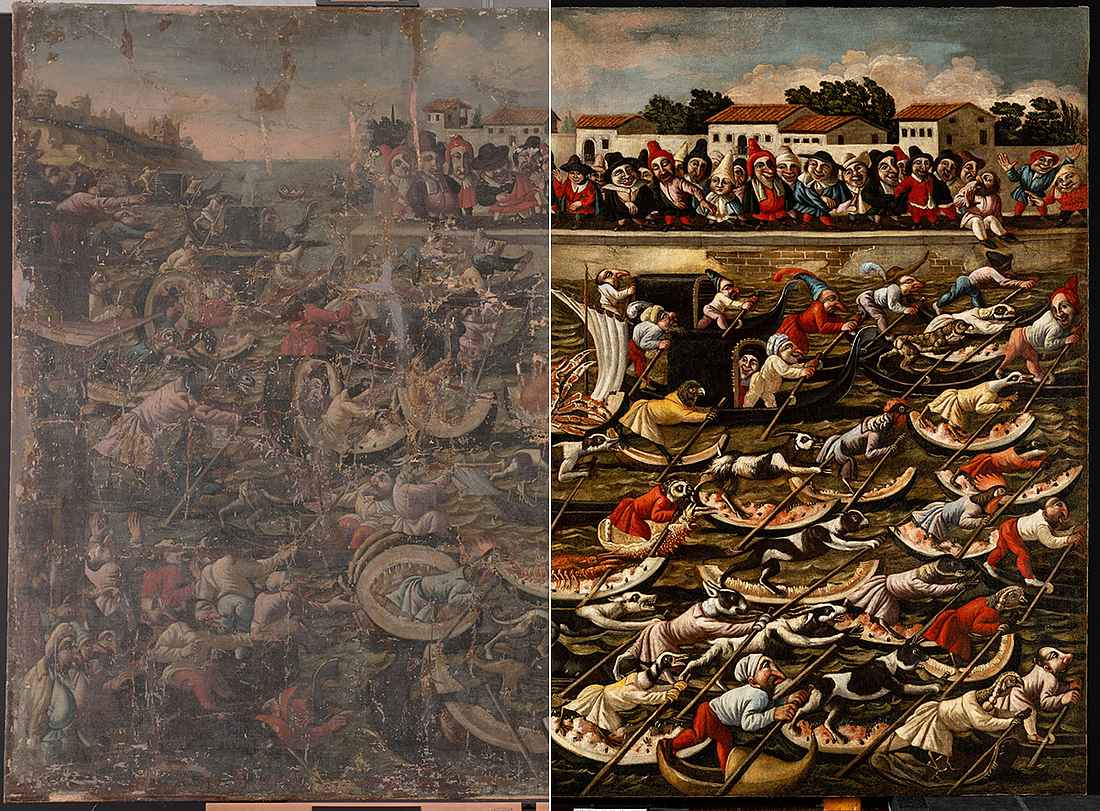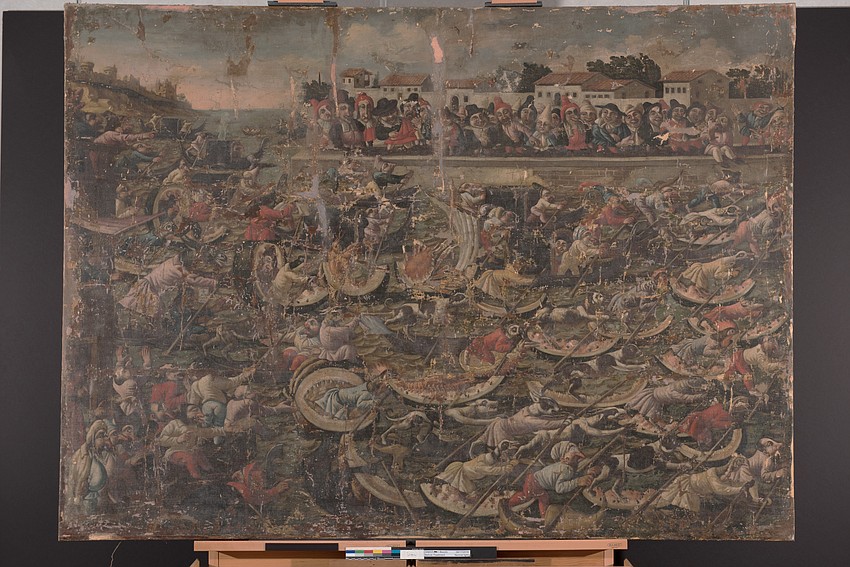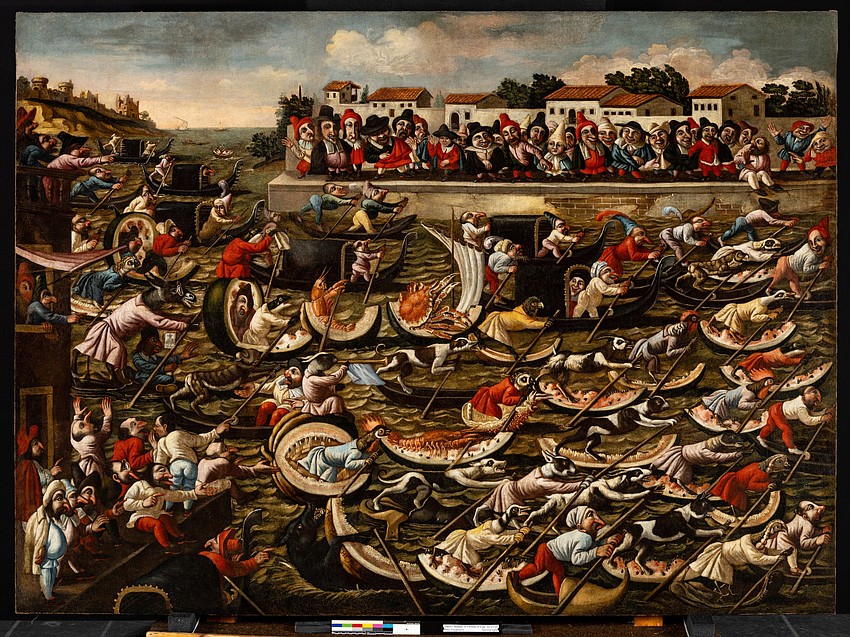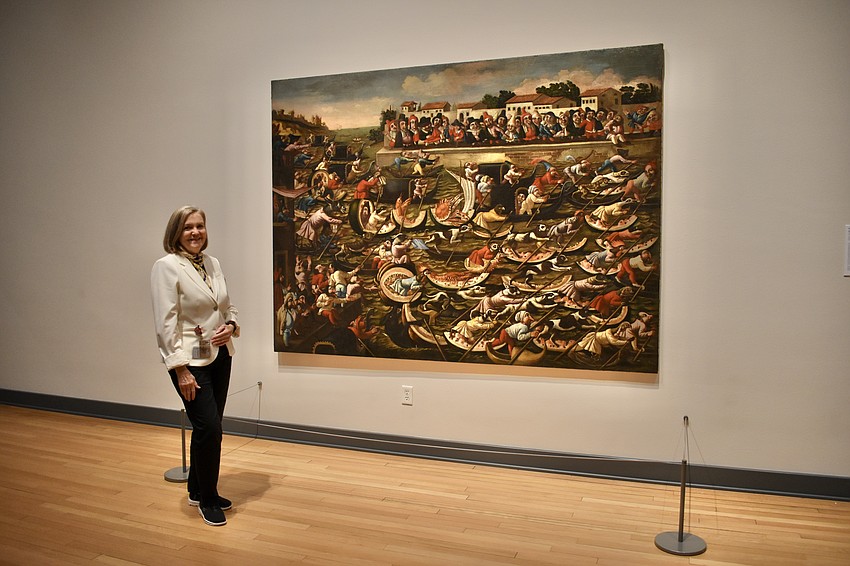- January 4, 2025
-
-
Loading

Loading

What's wrong with this picture?
The world in "Watermelon Regatta," an 18th-century painting created in Italy, is strange enough as birds, crustaceans and other animals race down a Venetian canal in gondolas cut from the rind of watermelons, cheered on by dwarfish, caricatured humans.
Yet over the last few years, even more was off-kilter about this painting than its world of reversed roles, as conservators at The John and Mable Ringling Museum of Art worked to restore what began as an image defined by grime, discolored varnish and overpainting.
It wasn't a level of effort they would have given to just any ordinary painting, but the strangeness of the artist's satire took hold of them, just as it now has a chance to do for museum visitors.
For the first time, the painting has found a place on the museum walls, in a devoted room that also features a slideshow on the restoration process.
It will remain on display there temporarily and eventually will join the larger collection, although no plans are currently set.
The identity of the artist behind the 70-by-96-inch oil painting on canvas may not be known, but the 18th-century painter still made a name in the art world as “Master of the Fertility of the Egg.”
Active in northern Italy around 1700, the painter was responsible for painting “Fertility of the Egg” at the Milwaukee Art Museum and created multiple works with the same figures and creatures.
“The subject matter is just really unusual and quite delightful,” said Chief Conservator Barbara Ramsay. “Today, we see all kinds of strange things, but probably in the early 1700s, there was not much else like this around. So it's amazing it survived, and it's been through a lot.”
No consensus exists among scholars as to the artist's identity, although according to Chief Curator Sarah Cartwright, possibilities have been suggested, including that the artist was Flemish. She noted this type of satire is associated in some ways with northern countries.
What is more easily apparent is the message the painting conveys.
“The artist has taken a satirical view of human life and human folly, poking fun at how arrogant humans can be, and how they’re so superior to the animals, and he’s turned everything upside down, so here’s it’s actually these other creatures that are involved and engaged in a race,” Ramsay said.


Although guests of all ages find something to enjoy in the painting today, for many years after it was donated to the museum in 1951 by its first director, Everett “Chick” Austin, it was largely illegible.
While it received a partial treatment decades ago before entering storage, much more extensive work would be required before it could find a place in the museum.
At the Ringling, the staff of conservators is small, but Ramsay still had to find a path for moving the work on the unique painting forward.
These conservation efforts, which began in 2017, had been the focus of The Ringling’s 2016 Giving Challenge, and were more recently supported by the David A. Straz, Jr. Foundation.
Over the past year, Ramsay began hiring private conservators to help finish the project.
A crucial part of the answer was found in the museum’s interns; the museum trains conservation interns, fellows and junior conservators, and "Watermelon Regatta," with its extensive damage, made an ideal teaching tool.
Don't be fooled into thinking that such a restoration is a task for all skill levels, though.
The background of a conservator must include plant science and organic chemistry, along with art history and studio art. Furthermore, the process at Ringling follows a strict ethical guideline of respecting the artist's original intent, adding no more new material than necessary.
A restoration begins with a thorough examination to distinguish between original and non-original paint, a process that includes photographing the painting and viewing it with ultraviolet, fluorescent and infrared light and X-rays.
As the work began, conservators had to set down paint that was lifting from the canvas and remove surface grime and discolored or dirty varnish, before removing overpaint by testing different combinations of chemicals.
It was those areas where paint was missing entirely where artistic skills became especially relevant.
When it comes to blank areas, conservators must paint over the area using the exact structure of what is found around it, while also mixing paints until they find a perfect color match.
“You have to be an artist. But normally you don't,” Ramsay said. “In most situations, you don't want to add anything; you don't want to let your artistic self take over and do more than you should.”
This inpainting work involves the use of extremely small brushes, and either dry pigments or synthetic resins developed for the conservation field. To help keep the canvas texture consistent, some areas of the painting were filled using silicone molds of the paint surface.

In still other areas, overpainting had to be done, for instance, in the case of the water in the picture.
Although intended by the artist to be a brown color, it had been painted over in bright blue that could not be safely removed, so conservators painted over that space once again.
With “Watermelon Regatta,” the conservators found plenty of reference points to ensure the authenticity of the restoration.
The painting’s repeating animal figures were helpful; Ramsay was able to reference one monkey in the painting to fill in the head of the same animal in another area. Other paintings by the same artist also provided a point of reference for the human figures.
The new exhibition, which features a slideshow on the restoration process, reveals the importance of conservation to the museum, Cartwright said.
“It's amazing,” she said of the talent on display. “It’s remarkable to have such expertise. We have large collections here, so ideally, we'd have an even larger conservation staff, but what they do is remarkable.”